10 tips to boost email engagement for better opens, clicks and deliverability
 Duncan
Duncan

- What is email engagement?
- How do you measure email engagement rates?
- What is good email engagement?
- How to improve email engagement
- 1. Clean your email list
- 2. Remove inactive subscribers
- 3. Segment your subscribers
- 4. Optimize your subject lines and preheader
- 5. Make it clear who sent the message
- 6. Include more links and clickable content
- 7. Use email surveys and quizzes
- 8. Use a treasure hunt
- 9. Ask questions
- 10. Provide benefits for replying
- Final step: Analyzing the data and improving
We'll discuss the two main ways to boost email engagement: ensuring your list is full of people who are interested in your business and then providing these people with high-quality content that encourages opens, clicks, and replies.
The article will also look at email engagement in further detail, highlight KPIs you can track, and provide engagement benchmarks you can use to compare your emails to others.
What is email engagement?
Email engagement refers to the level of interaction subscribers have with the emails they receive. It is an important metric for email marketing campaigns and is used to measure the effectiveness and success of email communication.
Good email engagement can also improve your email deliverability. Email inbox providers like Gmail see which senders have strong engagement and are more likely to deliver messages from these accounts to the inbox rather than the spam folder.
People who run email newsletters and sell ads will also benefit greatly from measuring email engagement. Ad buyers want to place products in newsletters with audiences that will interact with their content. They will typically pay more for ads in newsletters with high engagement.
How do you measure email engagement rates?
Email engagement can be assessed through various metrics. Most email marketing service providers track these email KPIs so it’s easy to see how well emails engage your users.
Here are six of the most insightful email engagement metrics you can use to track your digital marketing efforts.
Open rate
Open rate measures the percentage of subscribers who opened an email. A high open rate indicates that the subject line and sender information were effective in grabbing the recipient's attention.
One issue with email open rate is that all emails sent to the Apple Mail client are automatically marked as open. This means the open rate you see is typically much higher than your actual open rate.
But, it’s still a useful metric. Tracking open rate changes from campaign to campaign shows what works even if the exact percentage isn’t accurate.
Clicks and click-to-open rate
Clicks are the number of people who clicked on content in your email, while click-to-open rate (CTOR) is the percentage of the subscribers who opened the email who also clicked on the content. Both metrics are a strong indicator of how engaging the email is.
Because it’s impossible to track open rate accurately, it’s also impossible to accurately track CTOR. Due to the inflated open rate, your actual CTOR will typically be higher than the number you see in your account.
Replies
Email replies are a sign of strong email engagement, as they demonstrate an active interest in the content. When people reply to your emails, you signal to ISPs that subscribers enjoy your emails.
Spam reports and unsubscribe rate
People unsubscribe or mark emails as spam when they are unhappy with your content and don’t want to engage with your messages. A small number of spam complaints and unsubscribes is normal and to be expected. But high numbers of either can damage your sender reputation.
Conversion rate
Email conversion rate is the percentage of email subscribers who took the desired action, such as making a purchase, signing up for a newsletter, or filling out a contact form after clicking on a call to action (CTA). Use these metrics to see how well your email campaigns drive action.
Purchases
Many retail businesses use their email marketing campaigns to drive sales and revenue. Key e-commerce-related metrics include total orders and campaign revenue. You can see these metrics in your email dashboard by connecting your e-commerce store to your email service provider account.
What is good email engagement?
Good email engagement depends on multiple factors including the type of email, your target audience and your industry.
Our sister company MailerLite measured the engagement metrics of over 40,000 campaigns to discover average benchmarks you can use to see how your campaigns perform.
The report found the following:
The average open rate is 37.65%
The average click rate is 3.36%
The average click-to-open rate is 8.93%
The average unsubscribe rate is 0.24%
These metrics varied significantly across industries so it’s not necessarily an issue if your numbers are different. Check the full article on email benchmarks for further details and a full breakdown of engagement by industry.
Also, note that the data in the article came from email campaigns. Automated emails such as welcome emails that go out to new subscribers, abandoned cart messages, or transactional emails often have much higher engagement as they are sent at the exact time the recipient wants to receive them.
How to improve email engagement
In this next section, you’ll find 10 tips you can use to boost interaction. We’ll start with subscriber management strategies, and move on to ways to increase opens, clicks and replies.
1. Clean your email list
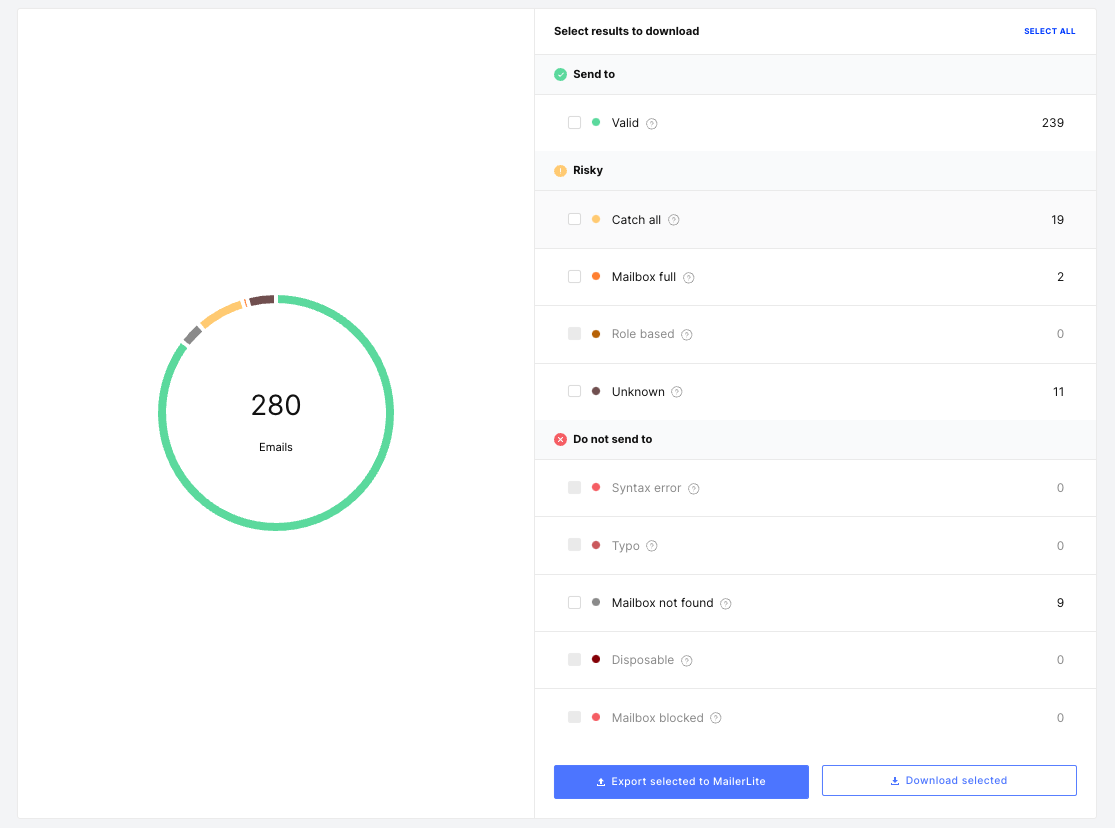
If left unchecked, most email lists will accumulate low-quality addresses that people don’t check such as spam bots, disposable addresses, spam traps, and role-based emails. Cleaning your email list is the process of identifying these addresses and removing them from your list.
Removing these addresses improves engagement because it increases the percentage of people who are actually interested in your content. This may increase your open rate.
Sending to fewer addresses that ignore your messages can also increase your deliverability and reduce email bounce rate. If this happens, your messages will be more likely to reach the inbox of the people who care about your brand.
Export your email subscribers from your email marketing service provider (ESP) and upload them to MailerCheck. We also have integrations with top email marketing service providers including MailerLite and Mailchimp.
Our tool will then analyze each of the addresses on your list and highlight those that are problematic so you can remove them. Click here to find out more about our email list cleaning tool.
2. Remove inactive subscribers
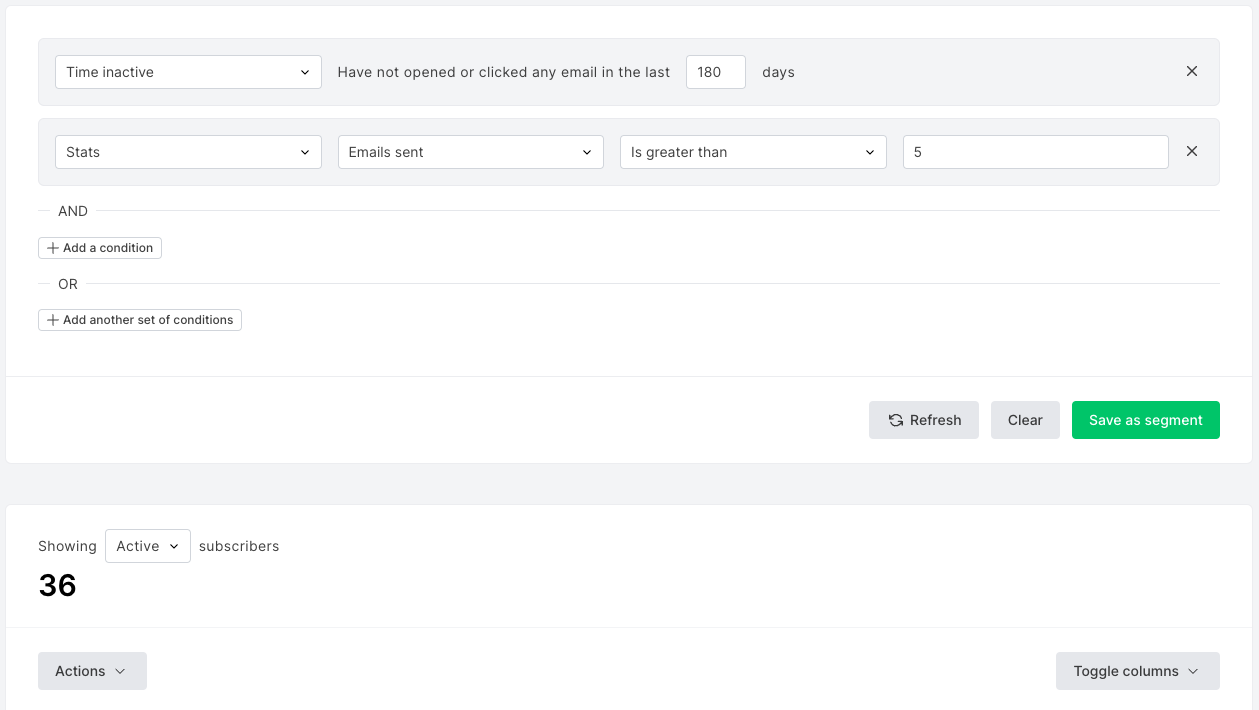
Inactive subscribers are people who were once interested in your product, company or newsletter, but have since lost interest and no longer interact with your campaigns.
Removing these addresses from your list will increase the percentage of people who are likely to interact with your messages, thus potentially increasing your open rate. And as a bonus, sending fewer emails and having a smaller subscriber list may lower your email marketing costs!
First, filter your subscriber list to see the contacts who haven’t opened or clicked on any of your emails in a predefined period. Most ESPs make this easy to do and MailerLite even tracks inactive subscribers automatically based on your criteria.
This could be based on a time period, such as the last six months, or it could be related to the number of emails they have received without engagement. The key is to choose a period that you're happy with based on your email-sending habits.
Once you have this list, you have two options. The first is to unsubscribe the contacts. The second is to set up a re-engagement marketing automation that sends a final series of emails designed to reignite the person’s interest in your brand.
If they interact with these messages, add them back to your list. If they don’t, remove them. Read this article for a complete guide on how to create re-engagement campaigns.
3. Segment your subscribers
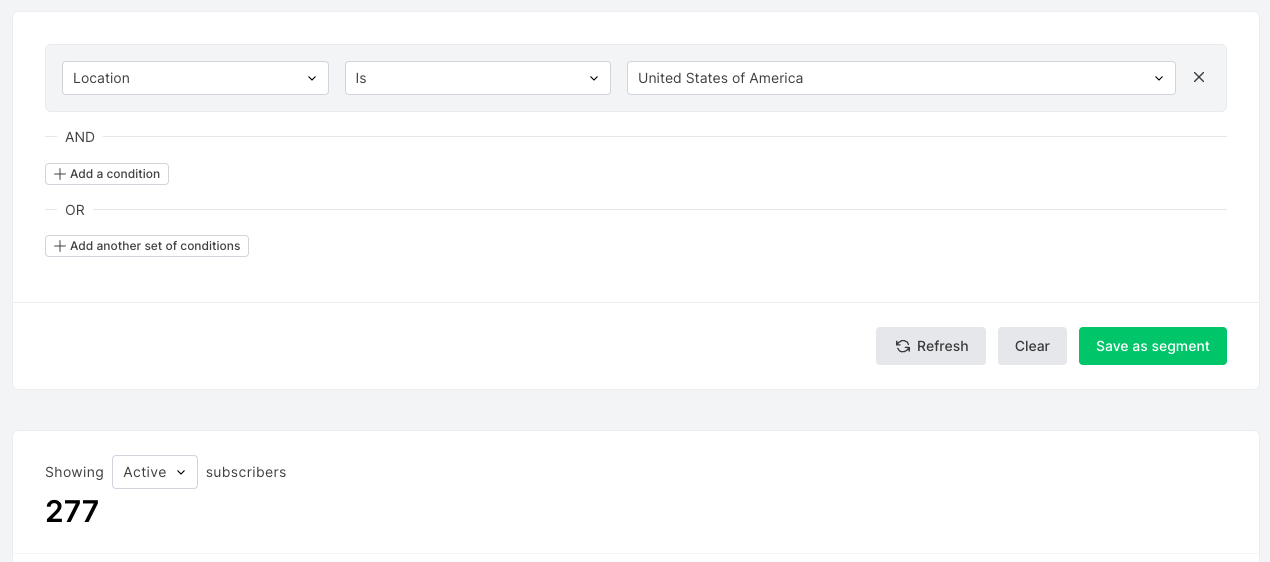
Our final subscriber management tip is to segment your subscribers based on their demographics or interests. This allows you to send content that is more relevant to their needs and thus more likely to boost engagement.
For example, a sports store could segment its list based on the activity people enjoy. It could then send content and product recommendations to people based on their interests, thus making them more likely to engage with the emails.
To segment subscribers, you first need to discover key information about them that will allow you to send targeted content.
Email marketing tools typically store information like location and level of engagement by default. You can also track data like survey answers and link clicks to see what people are interested in and segment your subscribers based on this data.
You can then send either dedicated emails to each segment or add dynamic content to your emails that changes depending on the person who receives the email.
Click here to learn more about how to segment your email list effectively.
4. Optimize your subject lines and preheader

Once you’ve completed the above steps, your list should be full of subscribers who are primed to engage with your content. Now for the hard part: actually sending content that connects.
The first step is to create a subject line and preheader that recipients can’t help but click on. These elements are your only chance to grab their attention in the inbox. If the subject line and preheader don’t connect, people are less likely to open your email.
Writing an effective subject line and preheader is more art than science. But there are best practices you can follow to increase the chances of your combo paying off.
Keep the subject line under 40 characters as this is what shows up on mobile devices
Include the most important information in the subject line, and secondary information in the preheader
Experiment with personalization to target the content at each subscriber
Test different types of content such as emojis, questions, numbers or offers and see what connects
Use A/B testing to see how different versions of a subject line perform
The key is to experiment and come up with a formula that works for your audience. Read more about the above tips and see a ton of subject line examples in this guide to writing effective email subject lines.
5. Make it clear who sent the message

The other element people see in their inbox is the sending name. There are 3 strategies you can use to optimize your name for opens.
Use your company name (or actual name if you’re sending a personal newsletter). Eg. MailerSend or Duncan
Use your company name alongside the name of the email sender. Eg. Duncan from MailerSend
Write your company name alongside “Team.” Eg. Team MailerSend
All these options make it clear who is sending the email so people interested in your product or newsletter know to click on the message.
Most email service providers allow you to choose the sending name people see in their inbox. Just head to the relevant section of the app and choose a name that meets your needs.
6. Include more links and clickable content
Good news, the subscriber has opened your email! Now you need to get them to engage with the content.
People can’t click on your messages if you don’t give them anything to interact with, so the easiest thing to do is to provide more clickable content and links.
Even if you already include links, adding more will increase the chances that the recipient will find something interesting to click on.
Start by adding more clickable content. When you add links, make sure it’s obvious that the content is a link. Use a different font color for all text links and use clear CTAs for buttons.
Consider adding links to:
Blog posts or website content
Products
Content on other websites
Past editions of your newsletter
Image galleries
Embedded social media posts
Look at past email campaign analytics to see what your subscribers clicked on. This will hint at the content types people find interesting and adding more similar content could increase clicks.
7. Use email surveys and quizzes
Surveys and quizzes increase clicks by giving customers content to respond to. Ask the right questions and people will be happy to answer. You’ll also gather crucial information you can use to improve your product or emails.
We’ve recently begun adding quizzes to our monthly newsletter at MailerCheck and our average click-to-open rate more than doubled! What's more, including this information helps us understand what the subscriber learned from the content while encouraging them to find out more.
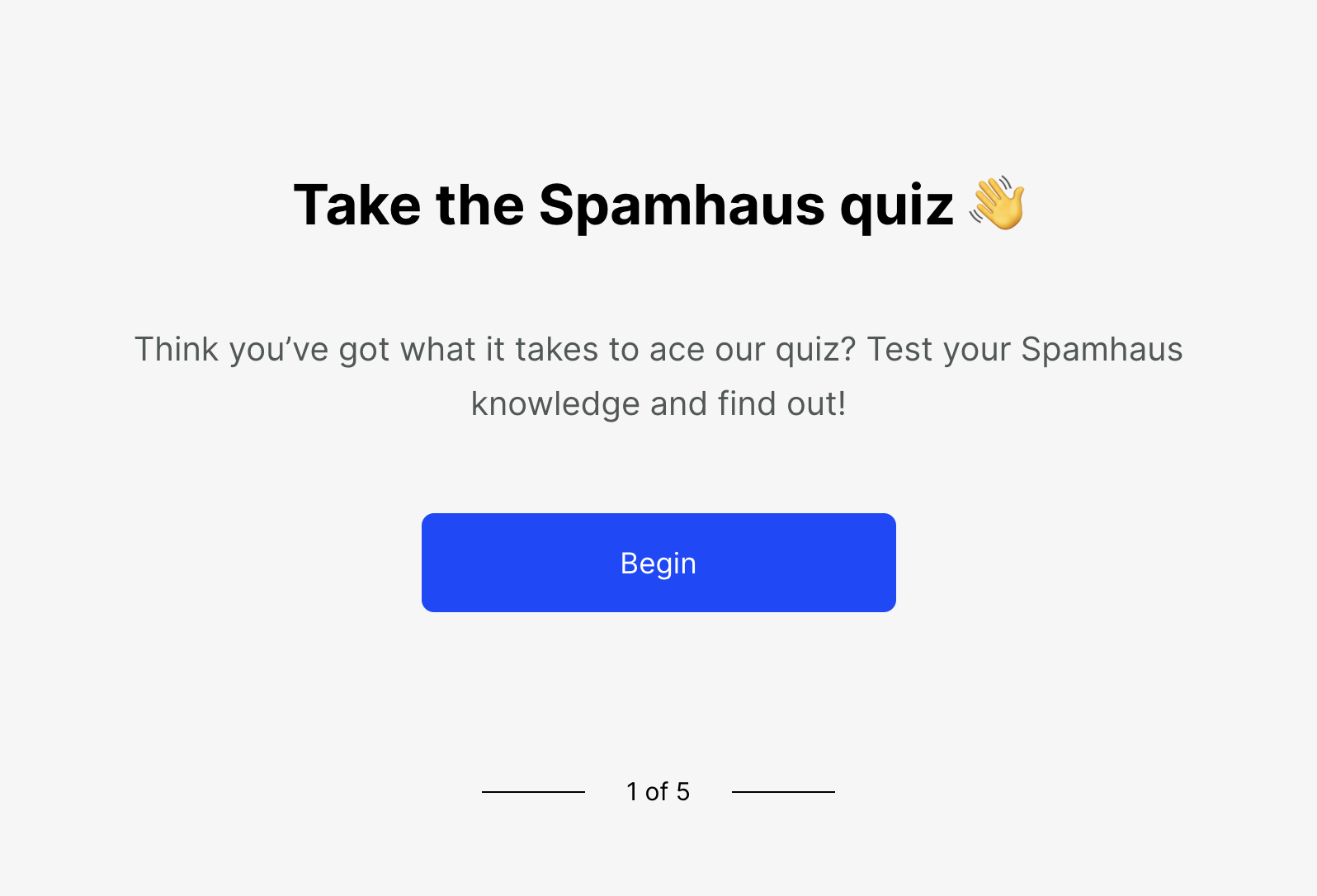
Some email service providers like MailerLite have customizable pre-built survey blocks that you can add to your emails. Just add the survey to the relevant position in your email, choose the colors, and configure the questions.
When adding the survey, experiment with showing the first question in your email rather than a slide showing a message like “Take our survey.” This way it’s easy for customers to quickly respond to the question rather than deciding whether or not they want to complete a survey.
8. Use a treasure hunt
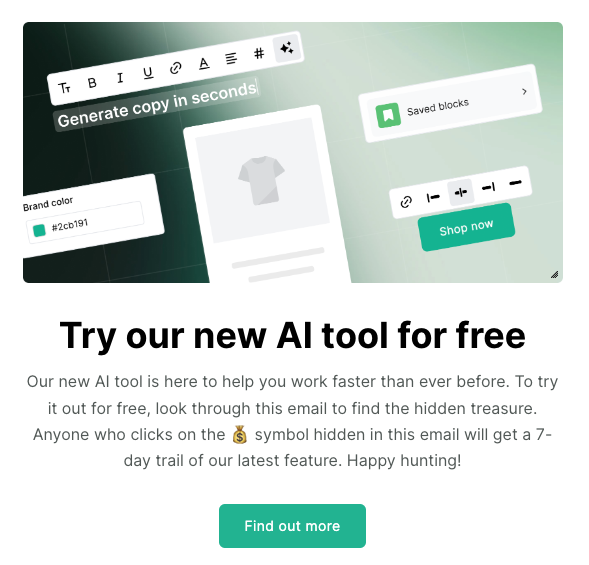
Treasure hunts are a fun technique we’ve seen some brands use to increase email clicks. The idea is that you hide a clickable element within the email and offer a reward to anyone who finds it. This reward could be entry to a competition, a discount coupon, or a digital freebie.
Start by introducing the game. Explain what that recipient should look for and the benefit they will receive from clicking on the link.
Hide the element further down the email and add a link to a page on your website. Emojis work well as they are easy to identify and linkable, and it’s possible to add them to any section of text.
Next, you need a way to identify which subscribers clicked on the element. How you do this will depend on your ESP. With MailerLite you can look in your campaign report to see a list of contacts who clicked on any link in your campaign.
You can also automate the process by creating a workflow that adds anyone who clicks on a particular link to a group of relevant subscribers or sends them an automated email with the reward.
9. Ask questions

Just like the key to getting people to click on your emails is giving them something to click on, the key to getting people to reply to your emails is to give them a reason to do so! Adding a question to your email and asking people to respond is the easiest way to do this.
Finish your email with a question for your subscribers about your email content or another topic likely to engage them such as requests for content ideas or feedback.
Be sure to highlight that you will actually read the replies and take action on the information you receive. You may also want to spend time following up with responses to build the relationship further.
10. Provide benefits for replying
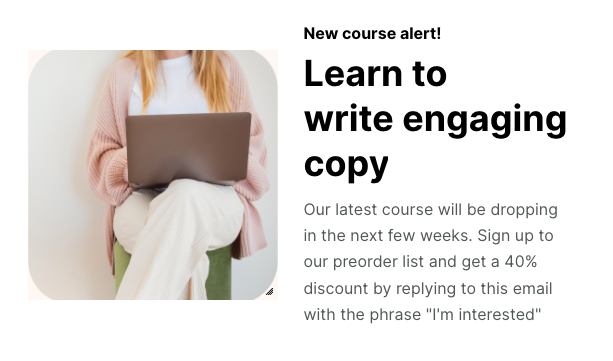
Another way to generate replies is to provide a benefit such as coupons, discounts or lead magnets to people who respond.
The issue is that people won’t receive instant access to your offer. You’ll have to manually check each reply and send the relevant content.
With this in mind, it’s best used as a strategy for things like pre-orders or generating signups for a product or asset that you are currently building.
Simply think of a benefit and add a section to your email explaining that people can access it by replying to the email.
Here are some examples:
Reply to this email to join the product waitlist
Get an extra discount on the launch price by replying to this email
Reply to this email to get the resource as soon as it’s finished
Be in with a chance to win by replying to this email with your name
Make it extra easy for people to reply by providing the exact text they should use. The downside to this strategy is that if you have a large and highly engaged list you may receive a lot of replies which can be time-consuming to handle.
Final step: Analyzing the data and improving
Once you start introducing these strategies into your emails, use data to check what people interact with and what they ignore.
Here are some points to check:
Open rate: Look at the subject lines of your emails with the highest opens and consider what about the content made it so engaging. It could be the offer, the type of content, or the fact you used personalization or emojis in the subject. Once you identify common traits, repeat them in your next email or future campaigns.
Clicks: Look in your dashboard to see the overall click rate and the exact things people are clicking on. Once you know high-performing content, roll out similar content in your next campaign.
Replies: Track which offers or questions result in the most replies. You might not be able to reuse the exact same questions every week, but you can roll out questions with a similar style or theme.
Also, don’t be afraid to experiment. As you’ve seen in our list, it’s possible to get creative with ways of generating engagement. And strategies that people aren’t used to seeing are more likely to stand out.
Have you used any other methods to generate engagement in your email marketing strategy? Let us know in the comments below!


